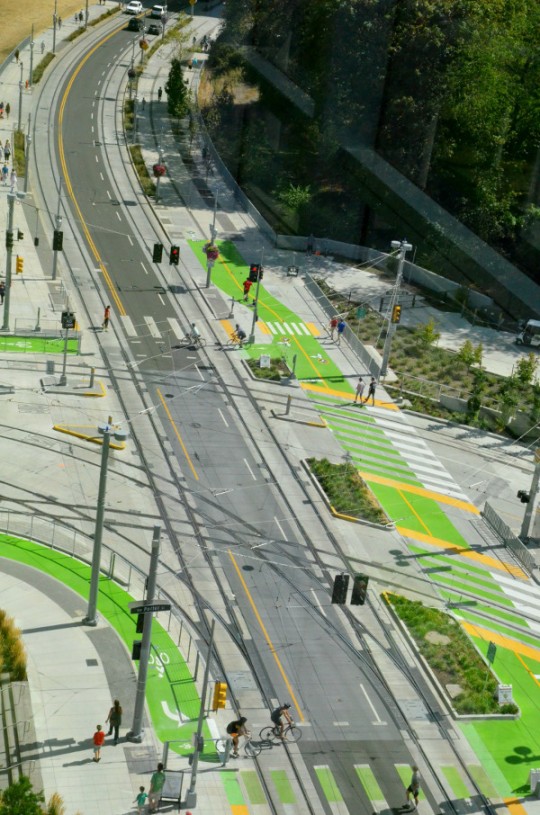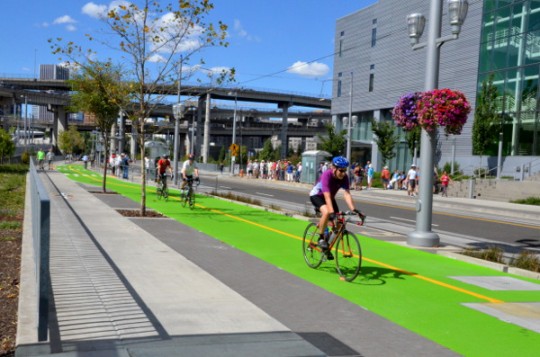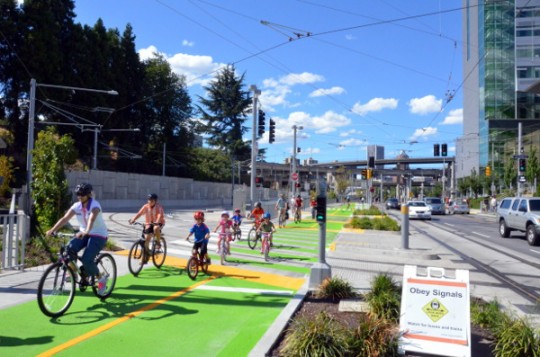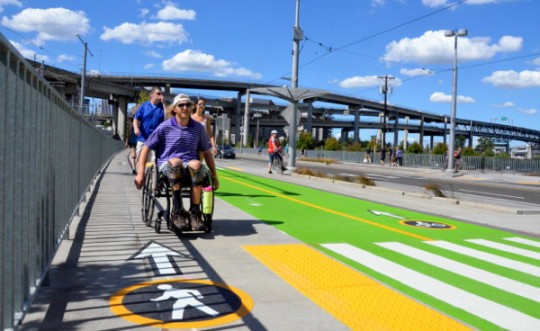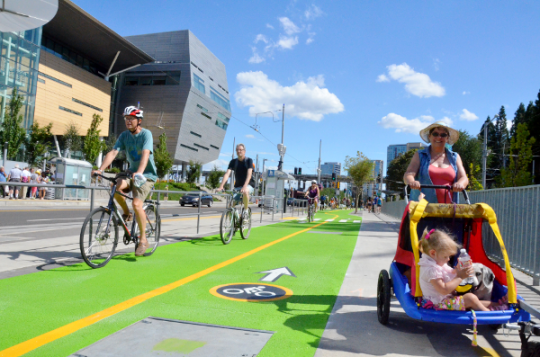
(Photos: M.Andersen/BikePortland)
Just in time for Tilikum Crossing’s public preview last weekend, TriMet and the City of Portland unveiled a new design for the main street leading to the South Waterfront.
In two words: It’s fantastic.
Gone: the confusing weave that sent people biking and walking across one another’s paths right below the Ross Island Bridge. Both bike lanes now remain on the curb side of the Moody sidewalk throughout, with people walking closer to the western hill side. The trees on the Moody sidewalk now serve as part of the buffer between people walking and biking rather than the buffer between the two directions of bike traffic, which is more intuitive and helps keep everyone out of each others’ way.
Upgraded: the lonely Hawthorne Bridge-style circles that mark which mode is supposed to go where. Backing them up in the most visible way possible: lots of textured green pavement coloring that makes it impossible to mistake the bike lanes’ route in the most complicated part of the street, just across from the bridge and the new OHSU-OSU-PSU Collaborative Life Sciences Building.
Moving the bike lane away from the hill also mitigates an awkward bend around a freeway support pillar further north on Moody.
Almost all of the $310,000 for these changes came from TriMet. That’d make it one of the most expensive bike-focused projects ever built in Portland, but it’s pocket change in the $1.5 billion Orange Line — which, as we reported in March, finished tens of millions of dollars under budget.
Why was the biking-walking “weave” on Moody in the first place? TriMet spokeswoman Mary Fetsch said it was because the city and TriMet had wanted to avoid sending bike lanes in between the sidewalk and transit stops on Moody — a design that’s widely used in other countries and cities but only exists in a few Portland locations.
Advertisement
However, the new design handles this nicely, getting the attention of people biking by prompting them to bend around the station and creating a marked crosswalk where, presumably, people walking have the right of way.
One aspect of Moody’s new design troubled me: the amount of time that north-south foot and bike traffic gets a red light at the bridge landing. Obviously red lights here are important when bus, light rail and streetcar traffic is crossing Moody. But the signal at Moody and the bridge also gives north-south traffic a red light every time someone gets a green light to cross Moody on foot or bike, which doesn’t seem necessary and threatens to create a sense that the signals can safely be ignored — which, of course, they can’t.
If there’s no east-west traffic detected across Moody, the light at the bridge landing is always green in the north-south direction by default.
Another big issue on Moody will be the length of the traffic signal for people crossing Moody coming on and off the bridge. It’s currently very long north-south and very short east-west, which will be frustrating to many people on bikes and seems likely to lead people to ignore the signal. During rush hours, when many people are likely to be heading eastbound from the Moody protected bike lanes across the bridge, the long signals seem likely to lead bikes to back up across the bike lane. You can see a little bit of that starting to happen in this photo from last Sunday’s bridge preview day:
Hopefully TriMet and the city will continue to treat those signal timings and other details here as works in progress.
Generally speaking, though, it seems to me and to the people I’ve talked to that anyone who uses Moody by bike or foot is likely to be well-served by these changes. John Landolfe, the transportation options coordinator for Oregon Health and Science University, said Friday that he’s a big fan of the new design.
“We submitted recommendations based on our observations of how Moody was used and feedback from OHSU commuters,” Landolfe said. “We’re delighted that TriMet and the city have opted to fast-track safety improvements ahead of the opening of the new bridge. … This street serves not just OHSU but the larger community. We want people to feel safe as they travel by bike, by foot, by rail or road.”
“Improvements generally don’t come as fast as you want them to,” Landolfe said. “This time we got it.”
Obviously there are lots of unique things about Moody that make it relatively easy to have such high-quality bike facilities there. There are no driveways, no conventional intersections and no on-street parking on this stretch. There’s very little commercial activity (yet); in many ways it resembles a short off-road path segment, even though this is part of a city street.
But that shouldn’t detract from the credit that the city, TriMet and other involved parties like OHSU deserve for making this as nice as it is. It’s simply the most intuitive, comfortable, low-stress set of bike lanes in the city. With the free bike valet at its south end, it already deserves to be a stop for every Portland bike tourist; this half-mile of first-rate bike infrastructure should be held up as a model of how well Portland can do these things when it sets its mind to it — and when it’s willing to learn from and correct its mistakes.
If all goes well, that’ll continue on Moody and elsewhere.
“I’m excited, but it’s of course a wait and see,” Landolfe added. “There might be future improvements too.”

